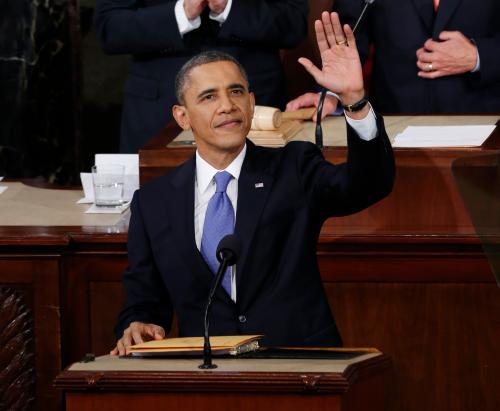As President Trump began his address to a joint session of Congress, four questions were on the minds of veteran political observers.
First, would the tone of the speech repeat, or break with, the bleak vision of the president’s inaugural address?
Second, would Mr. Trump help his own party resolve the internal disagreements that have stalled progress on his legislative agenda?
Third, would he extend a meaningful olive branch to Democrats?
And finally, would he offer any surprises that might reconfigure the political terrain?
To the president’s credit and—I suspect—to the relief of most Americans, President Trump did in fact change his tone substantially. Gone was the reference to American “carnage.” In its place was a more affirmative and hopeful attitude toward the future. “A new chapter of American greatness is now beginning,” he declared. “A new national pride is sweeping over our Nation. And a new surge of optimism is placing impossible dreams firmly within our grasp.” This tonal change is likely to produce an affirmative public response.
On the other hand, Republicans looking for guidance from the White House on intra-party policy disputes came away almost empty-handed. Despite general language that might be interpreted as supportive, President Trump had nothing specific to say about the controversial border adjustment tax at the heart of Speaker Paul Ryan’s plan, or about steps to prevent tax reform from worsening an already expanding long-term budget deficit. Other than a passing reference to giving governors “the resources and flexibility they need with Medicaid to make sure no one is left out,” there was little more clarity about the core issues that must be resolved to proceed with repealing and replacing the Affordable Care Act; in fact, a clear commitment to continuing coverage for individuals with pre-existing conditions may have made it more complex. The president repeated his $1 trillion goal for additional infrastructure investment over the next decade without clarifying the balance between public and private capital or the revenue sources for new appropriations.
The president extended some verbal olive branches to Democrats, declaring at one point that“[m]y administration wants to work with members of both parties to make childcare accessible and affordable, to help ensure new parents that they have paid family leave, to invest in women’s health, and to promote clean air and clean water, and to rebuild our military and our infrastructure.” The difficulty is that all these domestic initiatives must come from discretionary spending, which the president proposes to cut by $54 billion to fund his military buildup. One suspects that Democratic legislators will remain skeptical at best until Mr. Trump resolves this contradiction.
And there was a surprise—the president’s suggestion that the time was now ripe for immigration reform based on “merit”—that is, the possession of education and skills that will enable new immigrants to make an immediate economic contribution without straining public resources. As the president noted, countries such as Canada and Australia have such systems, which are working pretty well. And U.S. immigration reformers in both parties have long supported moving in this direction.
The difficulty, one fears, is that the Trump administration’s broadened deportation policy is likely to poison the well for Democrats. Nor is it clear that the Republican base is in any mood to address this issue. Still, the president’s demarche raises intriguing possibilities. If there is any issue on which Mr. Trump has the credibility to execute a “Nixon goes to China” strategy, it is immigration reform.
The Brookings Institution is committed to quality, independence, and impact.
We are supported by a diverse array of funders. In line with our values and policies, each Brookings publication represents the sole views of its author(s).








Commentary
President Trump offers a more hopeful tone but few specifics on policy
February 28, 2017